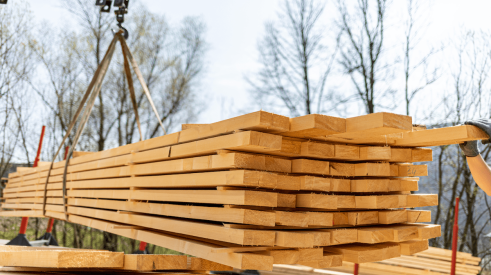The prices that many home builders pay for oriented strand board (OSB) structural panels have tripled since fall. The cost of dimensional framing lumber is up more than 37% since April, according to Random Lengths, which tracks lumber prices at the mills. Many steel products doubled in price during that same time. And more costs might find their way into new homes from the increase in crude oil prices.
Materials prices remained stable through much of 2003, so few builders anticipated increases in their 2004 pricing plans. Most of the hikes hit builders’ bottom lines because their prices must be set on perceived value in the marketplace, and customer perceptions of worth lag way behind what builders pay for materials and land.
NAHB economist Michael Carliner recently estimated it now costs $3,000 more to build a $200,000 house than it did a year ago. But many builders tell us the damage is worse than that.
Paul Schumacher, whose Schumacher Homes in Canton, Ohio, closed 285 homes last year (average price: $208,000) exclusively on buyers’ lots, estimates he’s taking hits of $5,000 to $8,000 on houses now under construction.
“That’s right off the bottom line,” he says.
Beat the Crunch
Management consultants say builders can protect themselves against materials price spikes. “Subscribe to Random Lengths to keep track of lumber and structural panels pricing,” Chuck Shinn advises. “Chart the pricing trends on as many materials as possible. A lot of this is seasonal. You can lock prices for three to six months and do it at seasonal low points.”
Shinn says builders should work closely with lumber suppliers to plan a purchasing strategy. “Right now, lumber is going up because the mills were closed all winter, and the industry has been running on existing inventory since fall,” he says. “By June, we’ll probably see prices go down.”
Consultant Scott Sedam says even small builders can work with a lumber supplier to get into a hedging program that will mitigate price spikes.
“You can spot-buy or use futures contracts to bridge peaks,” he says. “If you use futures to hedge, you can decide together what the target is. You don’t have to be huge to get into this because you can buy lumber a carload at a time. There’s no reason a builder doing 50 to 100 houses a year can’t use hedging to smooth out the cycles. The lumber dealer might put together a group of builders to go into hedging.
“Another strategy is to go into an agreement with the dealer to ensure your supply and then tie pricing to Random Lengths plus a percentage.”
That’s what T.W. Lewis Co. in Tempe, Ariz., did, though its framing contractor does the buying because Phoenix is a turnkey market. “Because plywood pricing has been so volatile, we’re on a 30-day index tied to Random Lengths,” says Tom Lewis, whose firm built 288 homes in 2003 for $142.4 million.
Lewis has more freedom than most builders to pass costs through to home buyers because he’s in a red-hot market in Phoenix. In Denver, where building permits were down 17% in 2003, builders can’t do it.
“Most of the time we can get 90 to 180 days of price protection on turnkey
lumber contracts,” says Jim Harmon, president of Aurora, Colo.-based Amber Homes, which builds 200 entry-level homes a year.
“The trouble is, builders here are giving $20,000 in incentives to sell a $200,000 house, so we have no freedom to pass cost increases to buyers.”
Suppliers’ Suggestions
Harry Seigle of Seigle’s Inc., an Elgin, Ill., supplier of dimensional lumber, plywood and OSB to Chicago-area builders, advises: “Avoid negotiating contracts for lumber pricing at calendar quarters and year-end. So many people do it then, it creates an artificial demand. Schedule your renewals a little out of sync with the rest of the world, like November 15.”
Seigle also advocates using more engineered wood products. “You’ll feel the volatility a lot less with trussed roofs rather than rafter roofs,” he says. A truss isn’t a pure commodity like a 2x8 rafter — its price reflects labor and overhead.
“The same goes for engineered lumber for joists,” Seigle says. “That pricing will be much more stable than 2x10 lumber in a surging market.”
Seigle suggests that builders who use OSB panels return to traditional plywood. “One of the reasons we are getting wild swings in panel pricing is that the market is now 60% to 70% OSB, and there are fewer producers of that product. The quality of plywood panels has improved. A shift back to plywood would diversify the supply base and relax pricing.”
Reed Kneale of Mentor Lumber in Mentor, Ohio, says any spike in dimensional lumber will be short-lived because that product can come from anywhere in the world, whereas OSB and plywood are tied more tightly to a limited number of North American mills. “However, we are getting plywood from Brazil that carries APA certification. And OSB from Ireland. I expect more of that in the future.
“The problem with hedging on the futures markets is you’re buying a hedge on 2x4s, not OSB,” Kneale says. “You’ve got to hope there’s a relationship between them, and that’s not clear today.”
He adds that new operational methods by lumber dealers cause some of the price spikes. “They used to make big buys in the winter, as Chuck Shinn suggests, and live off that inventory for months. But today, most yards are into just-in-time buying. They don’t want to get stuck with inventory when prices go down, so they use just-in-time to max their inventory turns. So the yards have no choice but to pay the prices the mills quote today.
“And 20% of the buys the yards make today are contract buys, where the price is not specified until Random Lengths comes out for the delivery period. Home Depot and Lowe’s work this way as well. That leaves price more in control of the mills.”
Big Oil’s Impact
Shinn advises builders to plan for the impact of oil prices. “It’s only a matter of time before all the materials that are petroleum-derived start to spike,” he says. “That includes a lot of plumbing and roofing products. Anything that’s plastic.”
And windows. “Northeast builders moved away from wood windows and use more vinyl,” Kneale says. “That’s a petroleum-based product. Sure as day follows night, a price spike is coming in vinyl windows.”
Advertisement
Related Stories
Sustainability
Fortera Takes Concrete Steps to Reduce the Climate Impact of Cement
Clean-tech company Fortera, which uses technology to capture carbon emissions form cement manufacturing, will open its first commercial-scale operation on April 12, 2024, in California
Building Materials
Lumber Leads Building Materials Prices Higher in March
Overall, the cost of building materials rose during March, with softwood lumber, gypsum products, and concrete all seeing price increases. Only steel mill materials saw price drops
Awards
6th Annual Most Valuable Product Awards
Drumroll ... Please join us in celebrating our 6th Annual MVP Awards winners, which represent the best in innovative building products






